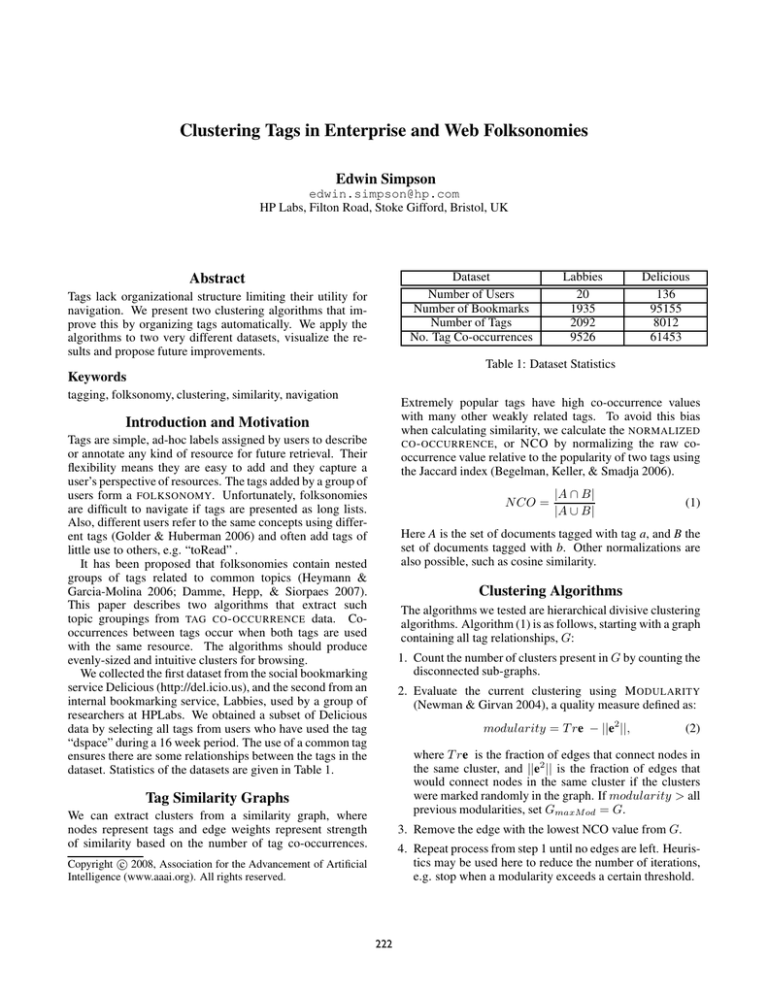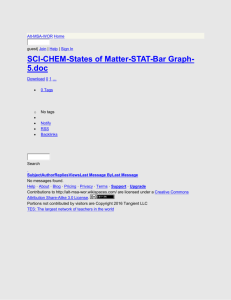
Clustering Tags in Enterprise and Web Folksonomies
Edwin Simpson
edwin.simpson@hp.com
HP Labs, Filton Road, Stoke Gifford, Bristol, UK
Dataset
Number of Users
Number of Bookmarks
Number of Tags
No. Tag Co-occurrences
Abstract
Tags lack organizational structure limiting their utility for
navigation. We present two clustering algorithms that improve this by organizing tags automatically. We apply the
algorithms to two very different datasets, visualize the results and propose future improvements.
Labbies
20
1935
2092
9526
Delicious
136
95155
8012
61453
Table 1: Dataset Statistics
Keywords
tagging, folksonomy, clustering, similarity, navigation
Extremely popular tags have high co-occurrence values
with many other weakly related tags. To avoid this bias
when calculating similarity, we calculate the NORMALIZED
CO - OCCURRENCE , or NCO by normalizing the raw cooccurrence value relative to the popularity of two tags using
the Jaccard index (Begelman, Keller, & Smadja 2006).
Introduction and Motivation
Tags are simple, ad-hoc labels assigned by users to describe
or annotate any kind of resource for future retrieval. Their
flexibility means they are easy to add and they capture a
user’s perspective of resources. The tags added by a group of
users form a FOLKSONOMY. Unfortunately, folksonomies
are difficult to navigate if tags are presented as long lists.
Also, different users refer to the same concepts using different tags (Golder & Huberman 2006) and often add tags of
little use to others, e.g. “toRead” .
It has been proposed that folksonomies contain nested
groups of tags related to common topics (Heymann &
Garcia-Molina 2006; Damme, Hepp, & Siorpaes 2007).
This paper describes two algorithms that extract such
topic groupings from TAG CO - OCCURRENCE data. Cooccurrences between tags occur when both tags are used
with the same resource. The algorithms should produce
evenly-sized and intuitive clusters for browsing.
We collected the first dataset from the social bookmarking
service Delicious (http://del.icio.us), and the second from an
internal bookmarking service, Labbies, used by a group of
researchers at HPLabs. We obtained a subset of Delicious
data by selecting all tags from users who have used the tag
“dspace” during a 16 week period. The use of a common tag
ensures there are some relationships between the tags in the
dataset. Statistics of the datasets are given in Table 1.
N CO =
|A ∩ B|
|A ∪ B|
(1)
Here A is the set of documents tagged with tag a, and B the
set of documents tagged with b. Other normalizations are
also possible, such as cosine similarity.
Clustering Algorithms
The algorithms we tested are hierarchical divisive clustering
algorithms. Algorithm (1) is as follows, starting with a graph
containing all tag relationships, G:
1. Count the number of clusters present in G by counting the
disconnected sub-graphs.
2. Evaluate the current clustering using M ODULARITY
(Newman & Girvan 2004), a quality measure defined as:
modularity = T re − ||e2 ||,
(2)
where T re is the fraction of edges that connect nodes in
the same cluster, and ||e2 || is the fraction of edges that
would connect nodes in the same cluster if the clusters
were marked randomly in the graph. If modularity > all
previous modularities, set GmaxMod = G.
Tag Similarity Graphs
We can extract clusters from a similarity graph, where
nodes represent tags and edge weights represent strength
of similarity based on the number of tag co-occurrences.
3. Remove the edge with the lowest NCO value from G.
4. Repeat process from step 1 until no edges are left. Heuristics may be used here to reduce the number of iterations,
e.g. stop when a modularity exceeds a certain threshold.
c 2008, Association for the Advancement of Artificial
Copyright Intelligence (www.aaai.org). All rights reserved.
222
these are general or ambiguous terms, which do not belong
in just one of specific cluster.
Algorithm (2) produced only 133 “clusters” with just one
tag, compared to 338 using algorithm (1). The largest cluster
was smaller with 126 rather than 191 tags. Since both singleton clusters and extremely large clusters do not divide the
folksonomy into useful topics, algorithm (2) showed better
performance with this dataset.
The clustering of Delicious data is also reasonable, but
the largest cluster for algorithm (1) has 716 tags, which is
likely to be difficult for users to browse. Algorithm (2) performed worse in this respect, with 4863 tags in the largest
cluster. Tags such as “Spain”, “university” and “relationships” are placed in the largest cluster, despite not being semantically close, suggesting the algorithms were unable to
divide the cluster sufficiently.. A possible improvement is
to modify the algorithms to prefer removing edges from the
largest clusters.
Another cause may be noisy data, so we tested removing
tags with less than 25 occurrences. With algorithm (1) this
reduces the largest cluster size to 87, and increase the proportion of clusters with 4 to 40 tags, suggesting that removing low occurrence tags may help create better clusterings
for browsing. However, with algorithm (2), the largest cluster still has 1115 of 1594 tags, suggesting that it would not
produce a good clustering for this type of data.
Figure 1: Clusters in Labbies (NCO in step 3.) root=”mit”;
cluster distance<2; min. tag use>2; NCO>0.06
5. Determine the tag clusters from the disconnected subgraphs in GmaxMod .
Algorithm (2) differs only in step 3. Instead of removing
edges with low NCO we remove edges with high BETWEEN NESS (Brandes 2001). Edges that lie on many shortest paths
between nodes in the graph have high betweenness. These
edges lie in sparse parts of the graph connecting two clusters, so high betweenness indicates the boundary between
clusters.
Conclusions
We tested two hierarchical clustering algorithms on two
datasets and visualized the results using a Spring layout. We
showed that some clusters produced may be too large for
human navigation, and that removing unpopular tags before
clustering can reduce this. Algorithm (2) used betweenness
to select edges to remove, which was effective for Labbies,
but performed poorly on densely inter-related tags in the Delicious dataset.
Visualization
References
We used a Spring Layout (Eades 1984) to position nodes
to visualize tag co-occurrence graphs generated from the
datasets. This places nodes closer together if they have
strong connecting edges. Nodes are colored to indicate different clusters. Due to the large amounts of data, we remove
edges where NCO value is below a threshold, and remove
tags with a low number of uses. We then select a sub-graph
to visualize by specifying a root cluster, and all tags within
a given distance, where distance is the number of edges between a given tag and the root cluster.
Begelman, G.; Keller, P.; and Smadja, F. 2006. Automated
tag clustering: Improving search and exploration in the tag
space.
Brandes, U. 2001. A faster algorithm for betweenness
centrality.
Damme, C. V.; Hepp, M.; and Siorpaes, K. 2007. Folksontology: An integrated approach for turning folksonomies
into ontologies. European Semantic Web Conference.
Eades, P. A. 1984. A heuristic for graph drawing. In
Congressus Numerantium, volume 42, 149–160.
Golder, S., and Huberman, B. 2006. Usage patterns of collaborative tagging systems. Journal of Information Science
32(2):198–208.
Heymann, P., and Garcia-Molina, H. 2006. Collaborative creation of communal hierarchical taxonomies in social tagging systems. InfoLab Technical Report.
Newman, M. E. J., and Girvan, M. 2004. Finding and evaluating community structure in networks. Physical Review
E 69:026113.
Results and Evaluation
Using visualizations we observed that both algorithms produced clusters reflecting the topics in Labbies. Figure 1
demonstrates this with clusters related to the topics ‘policies”, “digital library” and “semantic web”. The algorithm
has recognized the close relationship between the tags “reactive rules”, “policies” and “eca”, demonstrating that cooccurrence data can be used to identify topics. Popular
nodes connected to many clusters, such as “mit”, were separated into their own clusters. This is a sensible outcome as
223




